
The U.S. Army marketing slogan “Be all you can be” kept rolling around in my head as I learned more about the Eclipse 550. The flight from Charleston, South Carolina, would be my first in the new model, an upgrade from the Eclipse 500, which itself had several versions of varying capabilities during its short production run.
My previous experience, going back to the precertification models I flew and getting a type rating in the little jet in 2008, highlighted what the airplane wasn’t at the time—all that it could be.
The first airplanes out the door of the Albuquerque, New Mexico, factory in 2007 used a Garmin 496 on the glareshield as the long range nav system; it had no ability to fly anything but VOR/LOC/ILS-based approaches—no DME, no IFR GPS, no flight director; and the autopilot couldn’t fly a coupled approach.
But in concept, the Eclipse has always been a winner—a good-performing, easy- to-fly, single-pilot light twinjet made with modern manufacturing techniques and delivered for a reasonable price. However, the original company, Eclipse Aviation, ran out of money and goodwill before it could get all of the finishing touches done. Production ceased, bankruptcy ensued, and various suitors from around the globe came and went.
In the end, a group of owners led by Mason Holland, owner of the North American Jet charter company, bought the assets and formed Eclipse Aerospace. They immediately set about providing product support for the more than 250 airplanes already produced and established an upgrade plan for the early airplanes. Through it all, Holland said new production would only occur when the company was financially stable and when they could deliver an airplane that fit the original vision for the Eclipse.
Deliveries of that version, the Eclipse 550, started earlier this year and they in fact do meet that vision. Finally we have an airplane with the systems and avionics that one would expect in a jet—and some you wouldn’t expect in a light, or even a medium, jet. Most notable is the inclusion of autothrottles, which were originally envisioned for the airplane by designer Vern Raburn. In fact, every airplane produced had the servos and other gear for autothrottles installed in the center console, but the system was never fully developed.
With the introduction of autothrottles, the Eclipse 550 becomes the first light jet to offer such a feature. While the system is a $28,000 option, Holland hinted that anyone who is a good negotiator can get a better deal. With a list price for the 550 of $2.975 million, the autothrottle (A/T) option is less than one percent of retail. And a bargain it is. At that price it’s worth it just to impress your friends as it eerily moves the thrust levers all by itself.

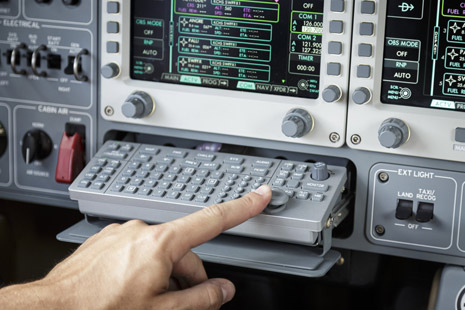
Learning the Avio interface is not difficult, but it is different from any other jet. Inputs can be via hard and soft keys on the displays or by dual pop-out keyboards.

Engine start? Turn the switch on the overhead.
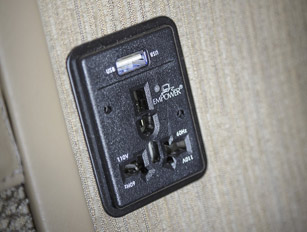
Passengers can power USB and 110-volt AC devices in the cabin.
During our flight, demonstration pilot Andy Smith had me turn the A/T on via a button on the autopilot mode controller on the glareshield. I then dialed in a speed and set up the autopilot for a descent. With that, the system managed the thrust to ensure we didn’t vary from the planned speed. A/T is especially helpful in the terminal area where a pilot might get busy dealing with ATC, looking for traffic, or setting up for an approach. Engaging the system to maintain a safe speed removes one worry for a busy single pilot.
Most helpful, the system is watching out for you even when the autopilot is off. In level flight with the autopilot off, I reduced thrust and held altitude. As the airplane slowed to just above stick-pusher speed, the thrust levers advanced on their own to maximum, keeping the pusher at bay. Similarly, in a descent or other overspeed situation, the A/Ts will decrease thrust to prevent a problem. A/T disconnects with gear or landing flap deployment. Yes, you have to manage the thrust yourself on the final segment of the approach.
Another 550 feature solves frequently cited problems with the 500s—poor braking, long landing distances, and blown tires. A new antiskid braking system allows pilots to stomp on the brakes after landing, or on an aborted takeoff, without fear of damage or blowing a tire. With a less than perfect approach, I was able to land the 550 in less than 1,000 feet by jumping on the brakes at touchdown. Holland says it can be stopped in as little as 700 feet. The original airplane had radial tires, which were prone to wear, and wimpy brakes that led to blown tires. New bias ply tires combined with antiskid make a big difference. “Anti-skid was not on our early road map,” said Holland. But a friend showed the CEO a system that he thought could work for the light jet. Holland brought in his engineering team, and soon the system was built, tested, and certified.
Other changes are more subtle, but still welcome, such as all-glass windshields with embedded heaters instead of plastic windshields that frequently deformed with heat application. The Garmin 496 was the only moving map on the early airplanes, but the 550 features a plethora of moving map options, although all of them look more cartoon-like in their presentation and color choices than those on most airplanes.
Also new are two standby display units on the upper left and right of the panel. The one on the co-pilot side is an option. In either case, they are independent sources of attitude, altitude, airspeed, and heading information. The original airplane had a backup pitot/static-based display embedded in the multifunction display, but it didn’t provide the level of redundancy expected in a jet.
Also new is an iPad app that includes the flight manual, quick reference guides, checklists, and a weight-and-balance computer to supplement the one built into the panel.

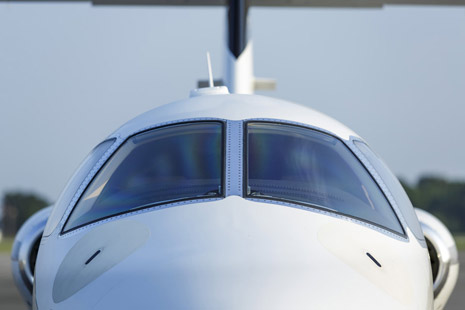
Glass windshields replace plastic ones on the original 500. Textured pads around the static ports (below windshields) help prevent ice build-up.
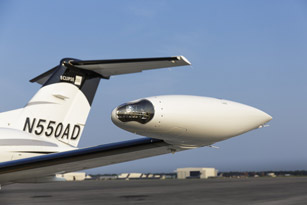
Fuel management is completely automatic, drawing down the tip tanks and then the main tanks.

Pumps automatically balance the load.
The good news is the company didn’t remove some of the features that make life simple for the pilot. The pressurization system is fully automatic and now automatically volunteers the elevation of your destination. A takeoff configuration system checks aircraft systems before allowing you to take off. The altimeters automatically switch to 29.92 when ascending through 18,000 feet. A three-degree profile is default when you command a descent—handy in busy airspace and when ATC wants you to come down—right now. You can fine-tune later, but it quickly and safely gets you going.
The safety features built into the airplane are an obvious source of pride for Holland. The fleet has flown 300,000 hours without an injury or serious accident—and zero fatalities. He credits the willingness of owners to embrace a strong training culture as key to that, along with the idea that the airplane was designed as a single-pilot airplane from the ground up. “To our predecessors, I give them a lot of credit for that,” he said.
At $2.975 million, the Eclipse 550 is by far the cheapest new jet available. In fact, it is hundreds of thousands of dollars less than many single-engine turboprops and 50 or more knots faster on about the same fuel burn. It is nearly $1 million less than the next most expensive jet, the Cessna Citation Mustang.
Still, some customers have complained about what they believe are the company’s efforts to corner the market on parts, including consumables such as brakes, tires, and batteries. Holland said many parts suppliers prefer to sell only through the airframe manufacturer as a matter of convenience and cost saving for them. Regardless, he claims that Eclipse pricing on those items is comparable to prices for those items for other jets and less than some turboprops. Eclipse sells batteries for $15 less than what a Mustang battery costs, he says.
Other customers we spoke to say that many of the complaints are from those who only recently migrated up to turbines from piston airplanes and have not yet adjusted to the costs, complexity, and training requirements that come with flying turbine aircraft.
However, even those who don’t like the parts pricing praise their airplanes. Every customer we spoke with, including two who have been flying their 500s for some seven years, say the airplanes day in and day out perform at or better than book and with very high reliability.
In numerous flights over the years, I’ve always seen the Eclipse perform at or better than book. As with other airplanes, it’s hard to find that optimal weight and ambient condition to meet the max cruise number of 375 KTAS—but nonetheless at normal altitudes and cruise profiles, the airplane reads the book on speed and fuel burn, with cruise fuel burns often around 60 gallons per hour total, leading to a direct operating cost of about $700 per hour (about $110 of which is engine reserves).
Eclipse is building about 1.5 of the jets a month. Sales are coming in faster than that. Holland says that rate will increase to two to three airplanes a month soon, mostly as soon as suppliers can assure deliveries at that rate.
With all of the upgrades to the 550, the Eclipse is finally all it was meant to be. With a sustained production run, it will assure its place as a contender in general aviation and not just a footnote.
Email [email protected]
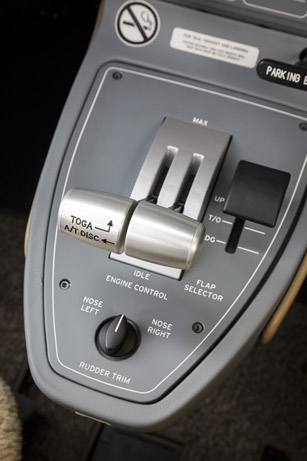
Autothrottles can be controlled from the autopilot mode controller or via a switch on the thrust levers.
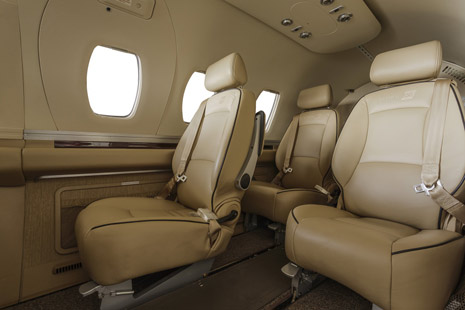
Most owners elect to fly with just three seats in the cabin, leaving more space for baggage.
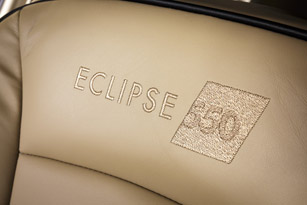
Stitching detail.
SPEC SHEET
Eclipse 550
Current base price: $2.895 million
Specifications
Powerplants | 2 Pratt & Whitney PW610F, 900 lbst each
Length | 33 ft 1 in
Height | 11 ft
Wingspan | 37 ft 11 in
Maximum wing loading | 41.5 lb/ft
Seats | 5-6, including cockpit
Cabin length | 12 ft 4 in
Cabin width | 4 ft 8 in
Cabin height | 4 ft 2 in
Empty weight | 3,634 lb
Max ramp weight | 6,034 lb
Max gross weight | 6,000 lb
Useful load | 2,400 lb
Payload w/full fuel | 702 lb
Max takeoff weight | 6,000 lb
Max landing weight | 5,600 lb
Max zero fuel weight | 4,922 lb
Fuel capacity | 251 gal | 1,698 lb
Performance
Takeoff distance, over 50-ft obstacle | 2,345 ft
Rate of climb, sea level | 3,424 fpm
Single-engine ROC, sea level | 989 fpm
Max cruise speed | 375 KTAS
Range, NBAA IFR | 1,125
Range, 45-minute reserve | 1,300
Max operating altitude | 41,000 ft
Single-engine service ceiling | 25,000 ft
Landing distance, over 50-foot obstacle | 2,250 ft
Limiting and recommended airspeeds
VFE (max flap extended) Takeoff setting | 200 KIAS
VFE (max flap extended) Landing setting | 140 KIAS
VLE (max gear extended) | 285 KIAS
VLO (max gear operating) | 200 KIAS
VMO/MMO | 285 KEAS/0.64 Mach
VO (operating maneuvering speed) | 180 KIAS
VSO (stall, in landing configuration) | 69 KIAS
Extra
Normal cruise fuel burn is about 60 gph total.
For more information Contact Eclipse Aerospace Inc., 2503 Clark Carr Loop SE, Albuquerque, New Mexico 87106; 877-375-7978; www.eclipse.aero
All specifications are based on manufacturer’s calculations. All performance figures are based on standard day, standard atmosphere, sea level, gross weight conditions unless otherwise noted.



